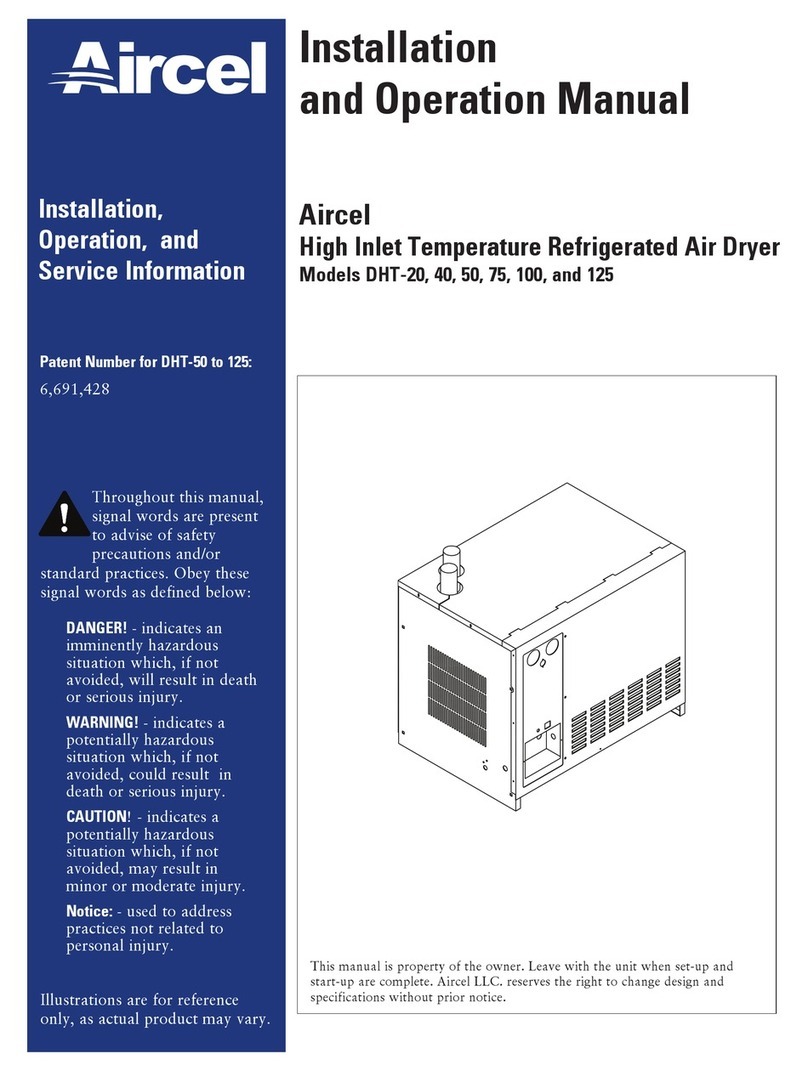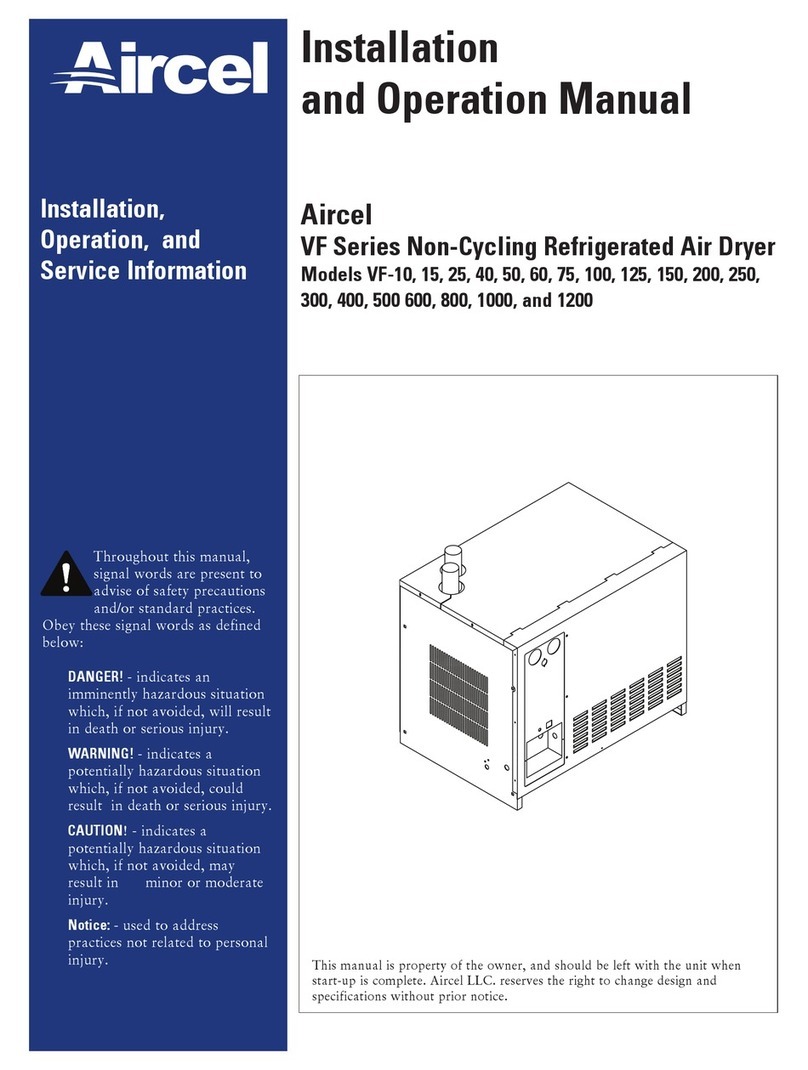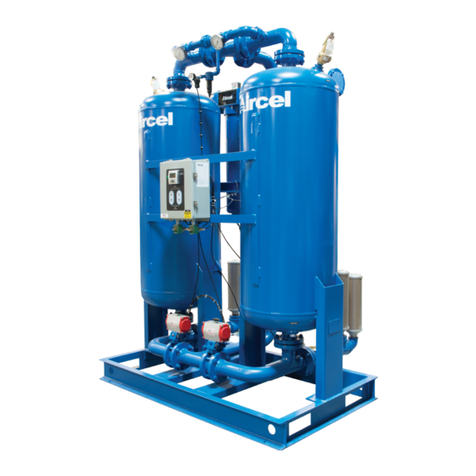
| VF, DHT, AES Series Manual
Refrigerated Air Dryer User Manual
4
2.1 Introduction
Refrigerated air dryers are designed to remove moisture
from compressed air by use of mechanical refrigeration
and are used to protect industrial compressed air systems,
machinery, and tools. They are designed to deliver the
required dew point at specified inlet air temperature,
inlet air pressure, inlet flow, and ambient temperature
conditions.
2.2 System
The VFS, DHT, and AES Series refrigerated air dryer
products cover the flow range listed on the manual front
cover and provides reliable dew point performance in
all flow conditions. Through optimization of critical dryer
components – heat exchanger, separator, and condensate
removal – the system ensures the highest performance at
full- and partial load conditions.
Hot saturated air enters the air-to-air heat exchanger of the
refrigerated air dryer and is pre-cooled by the outgoing dry
air. Pre-cooling saves energy by reducing the heat load on
the dryer’s compressor. The cool saturated air enters the
air-to-refrigerant heat exchanger where air temperature is
lowered to the 38 to 42°F range. This dramatic temperature
drop condenses water and oil.
The mixture of cold air and condensation then flows into the
two-stage separator filter where liquids and contaminants
are removed by centrifugal action, directional flow change,
and velocity reduction. Once bulk liquids have been
removed, the compressed air goes through a stainless steel
mist eliminating filter that coalesces oil aerosols and oil
vapors within the 50-micron range, and then separates and
removes them. At this point, the compressed air is dry and
virtually oil-free.
Cold, dry air exits through the pre-cooler heat exchanger
and is reheated by incoming hot air. Reheating restores
energy and also prevents condensation from forming on
the outside of air distribution piping. In the refrigeration
unit, the compressor pumps hot, high-pressure gaseous
refrigerant to the condenser where it is cooled and liquefied
by ambient air. From the condenser, liquid refrigerant first
flows through the receiver, then through a filter/dryer, and
finally through the expansion valve where pressure and
temperature are reduced. This reduction in pressure causes
the liquid refrigerant to boil until it reaches the saturation
temperature that corresponds to its pressure. As the low-
pressure refrigerant passes through the evaporator, heat
flows from the compressed air to the refrigerant, causing
the boiling to continue until all refrigerant is vaporized.
Refrigerant gas is returned to the compressor and the cycle
is repeated.
In the VF and DHT Series dryers, a hot gas by-pass valve is
used to control temperature in the evaporator. In the AES
Series, the Copeland Scroll Digital™ compressor allows the
system to eliminate the need for a hot gas by-pass valve.
The closed loop digital controller continuously monitors the
evaporator temperature and modulates the loading and
unloading of the refrigeration compressor based on current
load conditions.
2.3 Refrigeration Circuit
Refrigerant is cycled through a closed loop system commonly
known as high pressure and low pressure. Refrigerant
is compressed by the compressor to a gas with high
temperature and high pressure, which then travels to the
condenser (air- or water-cooled) to lower the temperature
and condense the gas into a liquid. Liquid travels to the
evaporator (refrigerant-to-air part of the heat exchanger)
and back to the compressor suction side. The process then
repeats. A hot gas by-pass valve is used on the non-cycling
VF Series dryers as a freeze protector in low load conditions
(100 scfm rated models [1/2 Hp] and up).
2.3.1 TYPES OF REFRIGERANT USED
R-134a refrigerant is used in dryer models rated 1200 scfm
and below, while R-404A is used in the VF-1600 and higher.
R-134a is a pure refrigerant providing consistent
performance (zero temperature glide) and easy service (no
mixture of different refrigerants). R-404A is a blend of three
pure refrigerants: 52% R-143A, 44% R-125, and 4% R134A
(by mass). This blend is nearly azeotropic meaning it has a
negligible temperature glide. R404A is well suited to larger
is nearly azeotropic meaning it has a negligible temperature
glide. R404A is well suited to larger equipment as the higher
operating pressures and improved heat transfer properties
allow for smaller condensers, which leads to air dryers with
smaller footprints.
2.4 Compressed Air Circuit
The compressed air dryer circuit uses a patented air-to-air
heat exchanger (VF Series 50 scfm and up, DHT Series 40
scfm and up), and stainless steel brazed plate air-to-air heat
exchanger (AES Series). These heat exchangers act as a pre-
cooler/reheater. Hot, saturated, compressed air first enters
the air-to-air heat exchanger, where it is pre-cooled by
outgoing air from the air-to-refrigerant heat exchanger. This
energy saving heat exchanger provides several advantages,
SECTION 2: DESCRIPTION






























